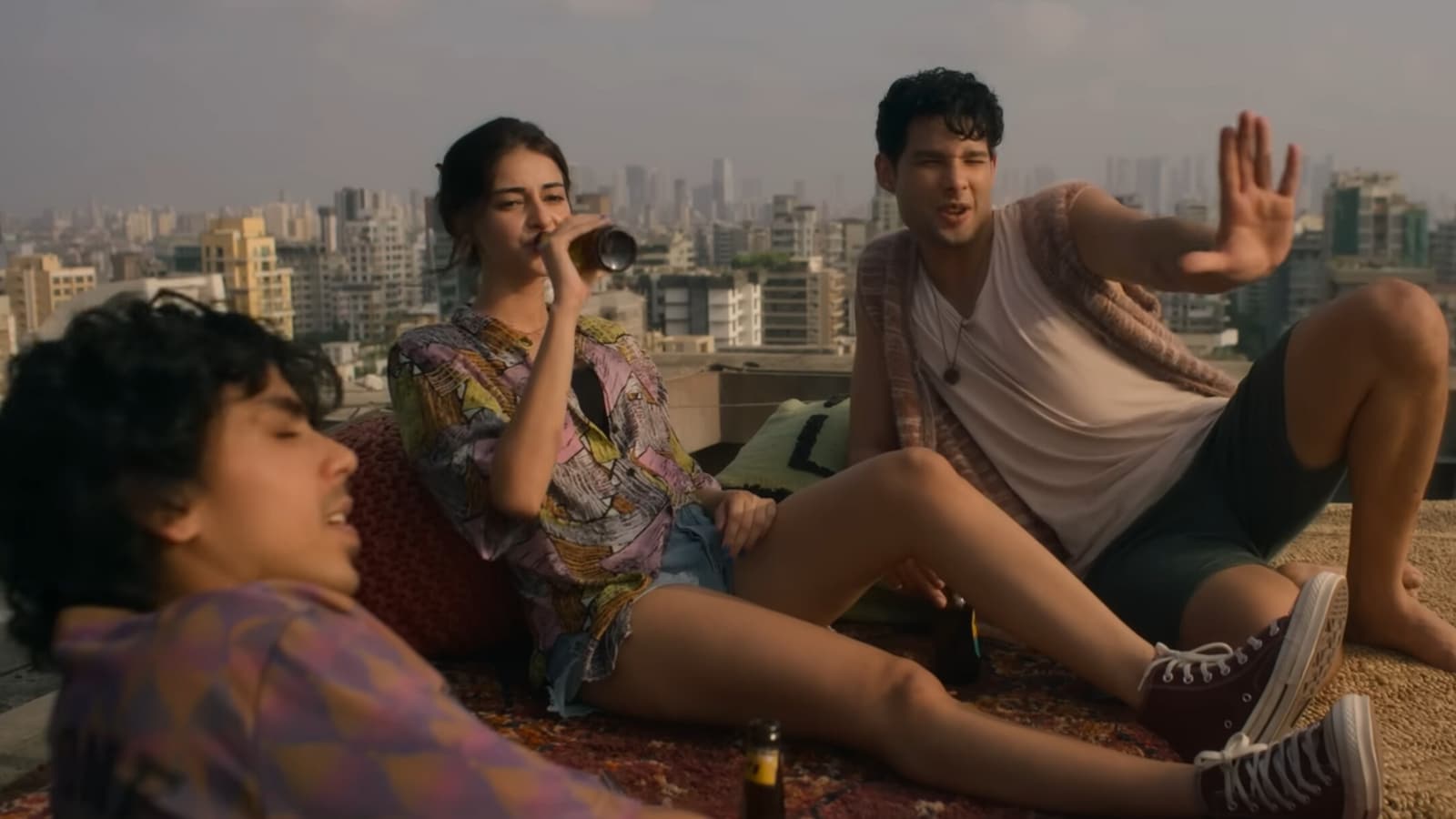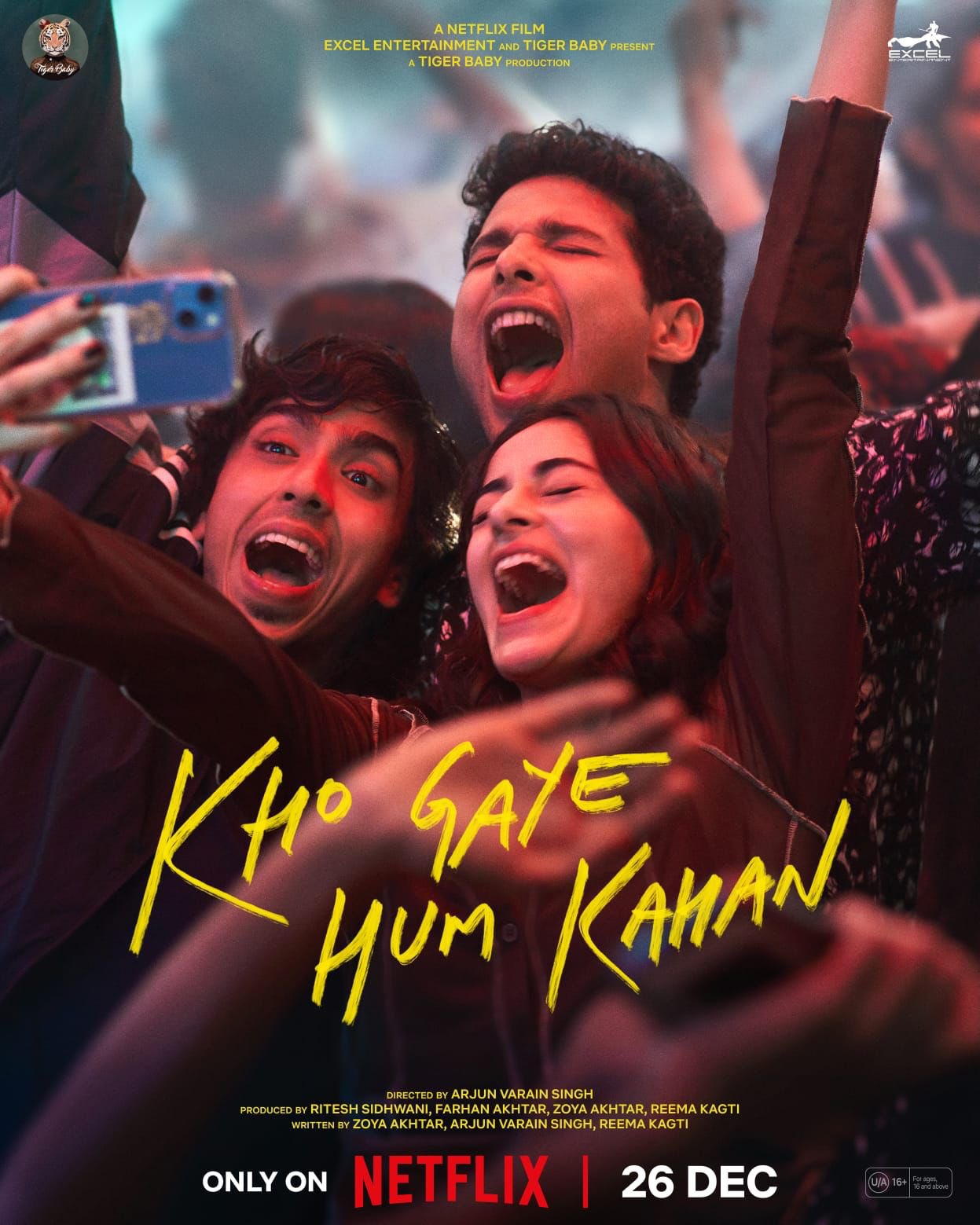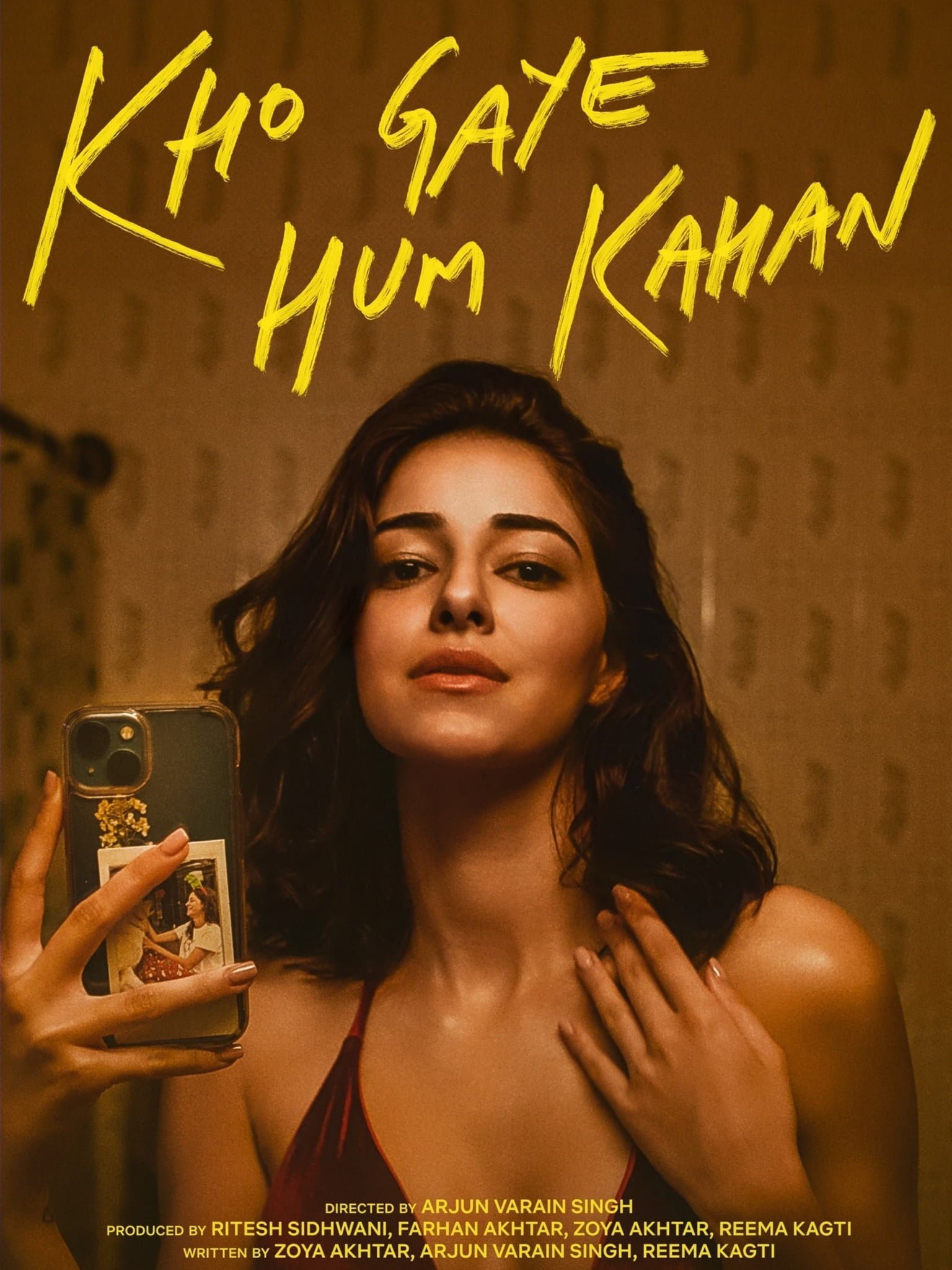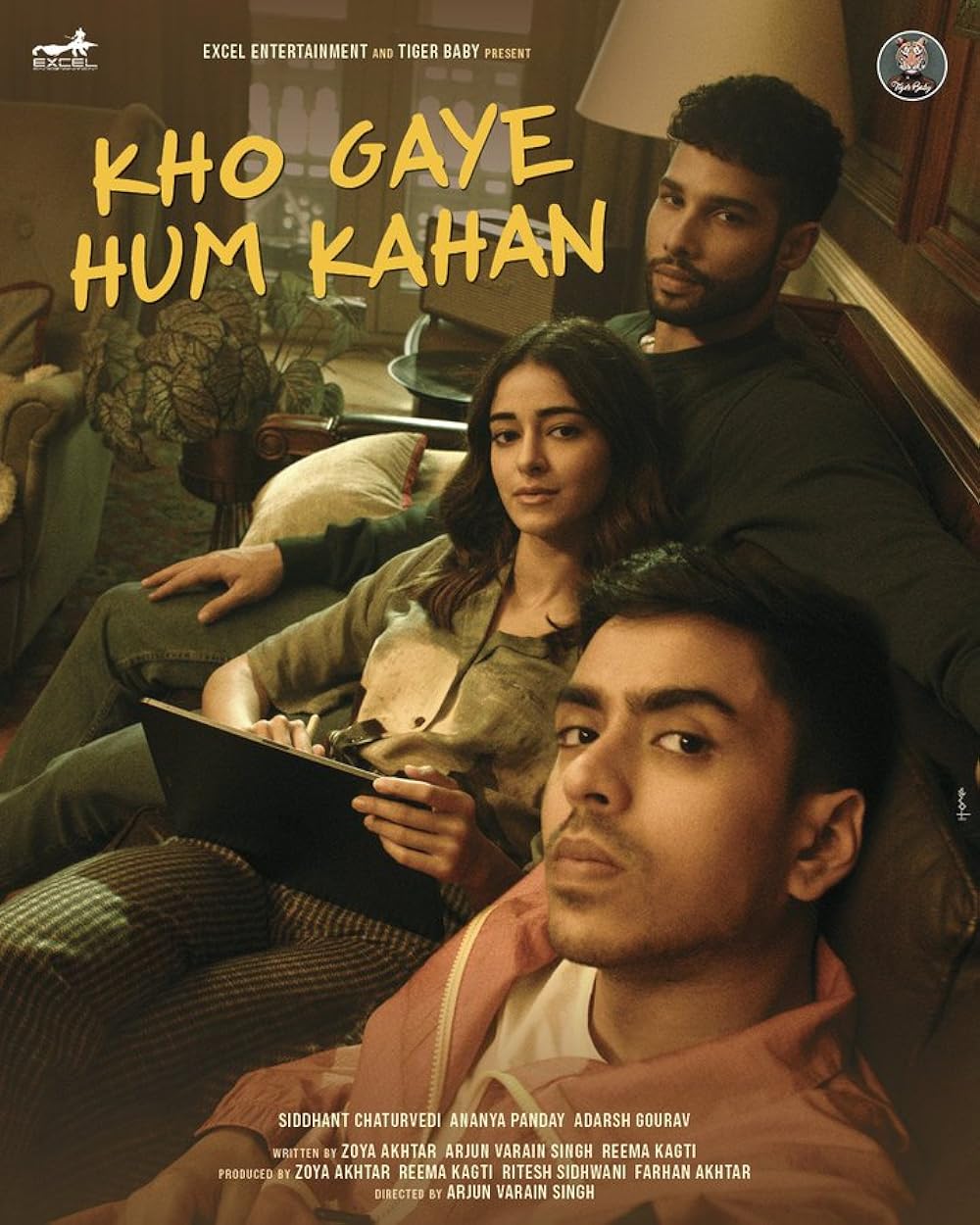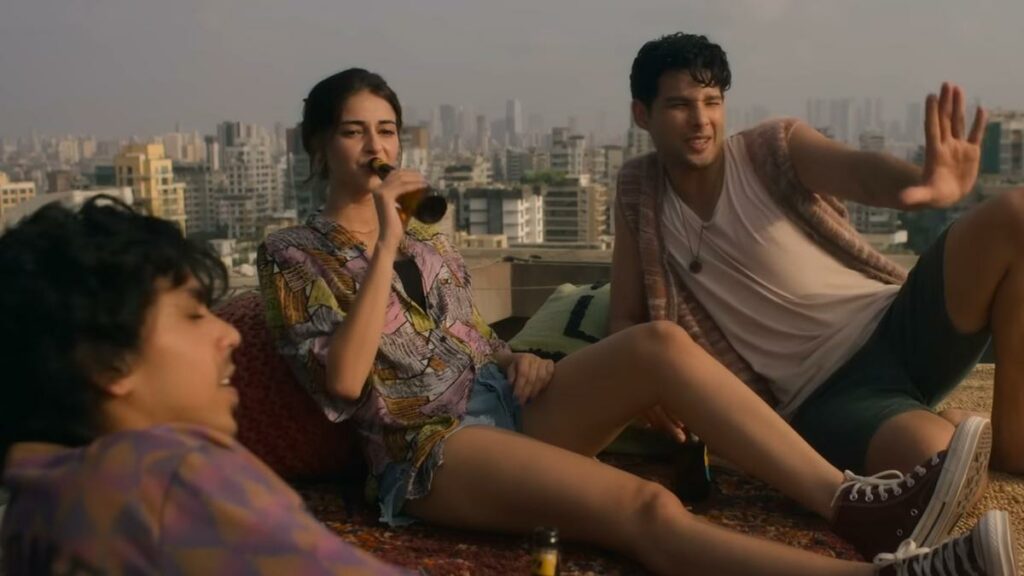Zoya Akhtar and Arjun Singh’s Kho Gaye Hum Kahan lays down a simple and raw portrayal of the lives of young people in their 20s who are navigating their way through the facade of an appealing existence on social media. The film revolves around the lives of three best friends Ahana (Ananya Pandey), Imaad (Sidhant Chaturvedi) and Neil (Adarsh) who went to boarding school together and interweaves itself in their struggles and the nuances of their being. The camaraderie laid down in the film is applaudable as it builds itself around aesthetic stills and the rawness of youth in their outward fashion and their mundane lives. The film has the vibe of an Instagram video in its stand-up drawings, relaxed attire, and soft mood board making it more relatable to the masses. The film strikes the right chord through its discourse but certain stills felt incomplete.
The plot of Kho Gaye Hum Kahan
Kho Gaye Hum Kahan was released on 26th December 2023, directed by Arjun Varain Singh and co-written by him, Zoya Akhtar and Reema Kagti. The film stars Imaad (Siddhant Chaturvedi), Ahana (Ananya Panday) and Neil (Adarsh Gourav). In addition to being best friends, Ahana Singh (Ananya Panday) and Imaad Ali (Siddhant Chaturvedi) also live together. Imaad likes to joke that they’re in a ‘spaceship’ because they give each other enough room to live in separate rooms. Neil Pereira (Adarsh Gourav), the third member of the group and their best buddy, works as a gym trainer with plans to launch a chain of fitness facilities.
Ahana is devastated when her boyfriend Rohan Bhatia (Rohan Gurbaxani) abruptly leaves her because he ‘needs a break.’ She uses reverse psychology to appear as though she has moved on by sharing her joyful photos on Instagram, but in reality, she is still watching her former partner, his whereabouts, and the new users he is connecting with or following. In the meantime, stand-up comic Imaad enjoys making his audiences laugh by using the problems in his friends’ lives as fodder for his jokes. When he’s not performing comedies, he’s either using dating apps to swipe ladies left and right and hooking up whenever he gets the chance, or he’s going to therapy to get over the scars from the past.
When Imaad meets Simran (Kalki Koechlin), a photographer who is a little older than him, perspectives do shift, but Simran’s fixation with social media keeps him from staying long. In a different subplot, Neil trains Lala, an influencer with a million followers, in her home in the hopes of one day landing some major celebrity clients to further his reputation. He is so charming that she has even invited him to vacation in the Maldives with her. While attempting to make something of their lives, all of them learn that their attempts to stay connected online have caused them to lose sight of what real life is like.
The performances in Kho Gaye Hum Kahan
Ananya Pandey has the opportunity to showcase her acting skills once more after Gehraiyaan last year, but this time with a character that is far more nuanced and well-written. She is a free-spirited, fun-loving, and vulnerable modern girl—but not at the expense of her morality. She has plenty of room to act, especially in emotionally intense sequences, because of this dimension to her character. Siddhant’s performance as a stand-up comedian on TV is so smooth and organic that you would think it was one of his side gigs.
Siddhant’s performance as a stand-up comedian on TV is so smooth and organic that you would think it was one of his side gigs.
He doesn’t allow you to become sidetracked and wants a strong screen presence. Following his highly praised online performances, Adarsh breaks loose in Kho Gaye Hum Kahan. He is way more relaxed, and confident and forms an instant connection with the audience. Perhaps the most layered character out of the three protagonists, Adarsh never appears overwhelmed and holds his ground.
Social media and the loss of human connections in Kho Gaye Hum Kahan
‘Social media makes you feel that you are more connected with people around, but in real, you have never been more lonely than this,’ is a remark from Kho Gaye Hum Kahan that will stick with viewers. The line so beautifully strikes the contradiction we live in, as a society. Though through social media the world has become a global community and is widely interconnected yet we are more disconnected from our loved ones and reality than we can ever be.
Gen Z is living their life under the influence of social media and its problematic ideals of living the good life. The film in its pragmatic yet direct approach shows the true portrayal of a young adult, not showing youth in the glitz of blinding fashion and indulgence of extravagance, but rather in their true and most vulnerable selves. There is a line that the film narrates, ‘an average person checks their phone 234 times a day’. It becomes evident that the film wants its storyline to be relatable to the realm of social media addiction.
A beautiful still from Kho Gaye Hum Kahan that talks about social media addiction is the scene where Ahana (Ananya Pandey) starts stalking her boyfriend with a fake account to know his whereabouts. The scene takes place when Ahana is at her office space and she sits with her coworker in the hallway with concentric stairs that create a whirlpool-like structure, signifying the labyrinth of distress of external validation and social media addiction. Another scene of Ahana trying to make her boyfriend jealous as she posts a sensuous picture online as Imaad (Siddhant Chaturvedi) tries to reason with her saying that is not the real her, brings out the need to feel validated for one’s worth in form of external appreciation
Misogyny and vulnerability through the rawness of youth
Social Media is a boon and bane in its entirety. The more addicted we are to the dopamine and the external validation it provides, the more we need it. Kho Gaye Hum Kahan shows the life of Lala who is a social media influencer with one million followers and how she is dating Neil, a gym instructor who wants to open his own fitness and gym studio. The portrayal of their relationship shows the lies and the dark side of social media.
Kho Gaye Hum Kahan shows the life of Lala who is a social media influencer with one million followers and how she is dating Neil, a gym instructor who wants to open his own fitness and gym studio.
Lala is stalked and harassed by a middle-aged man who lives across the street who captures her inadvertently, and posts her pictures on the internet without consent. This is later followed by Neil confronting him. The man openly says, if she can shamelessly wear such clothes openly, why is he reprimanded when he tries to capture her on camera? This scene depicts the misogynistic mentality that many people in our society hold on to.
In another scene, Neil is frustrated with the his day and he disguises himself as a social media bully where he trolls famous personalities and later Lala for cheating on him. The scene is powerful in its intention to talk about how trolling a person is a sign of mental health distress for the troller himself. The scene where Neil openly apologises to Lala for hacking into her account and trolling her feels half-baked as there is no later development of how it ends. However, it does shed light on the brighter side of social media, of how it is also used to share the truest thoughts and hold accountability to the community we build on it. Social media, no matter how optimistic or negative, often holds the reflection of one’s truest state of mind.
The portrayal of loneliness and traumatic experiences
Ahana in her fight with her boyfriend falls into the cycle of loneliness and demanding validation from her social media. As she takes a day off from work and lies in the mundane routine, she searches for quotes of loneliness. This is such a subtle yet beautiful stance that Kho Gaye Hum Kahan tries to lay bare. Though one is well accomplished by every standard of the society, there are weak moments in everybody’s lives, where they need that validation, no matter where they seek it from.
Another poignant scene is where Ahana confronts her boyfriend about the night they spent and how he tells her that it was a mistake. This leads to her realising how toxic and saddening it was to place her self-worth in the hands of someone who does not value her, Ananya Pandey beautifully portrays her role here telling the audience the importance of self-love and self-worth.
On the other hand, Imaad suffers from intimacy issues because of his childhood, and he ends up in the hookup and speed dating culture.
On the other hand, Imaad suffers from intimacy issues because of his childhood, and he ends up in the hookup and spoed dating culture. The humour and the dialogues of his character are efficiently written portraying his character who uses comedy and casual dating as a defense mechanism. The fighting scene between Imaad and Neil denotes the use of crude humour as a defence mechanism as Imaad goes overboard with his jokes based on Neil and his personal life.
The cameo of Kalki Kochelin as Simran, a photographer, adds a significant stance to the ensemble of the film. Her relationship with Imaad makes him realise that relationships can be beautiful and meaningful too, only if one is ready to heal themselves and confront their fears.
The last standup of Kho Gaye Hum Kahan where Imaad accepts his childhood trauma of being sexually assaulted and how important it is, to be honest to oneself and one’s loved ones is the masterpiece of the duration, urging not only youngsters, but everyone to realise the inner conflict and accept it to be a strong survivor.
The story is made even better by the author’s decision not to take a sanctimonious stance. No dull monologues are trying to convince you why you should or shouldn’t use social media. Kho Gaye Hum Kahan tries to impart a life lesson, but it does it very subtly and does not give any rules about what to do or what not to do. The film in its modest cinematography, simple yet aesthetic and modern couture and relatable and uncomplicated dialogues makes for beautiful and compelling experience. Though incomplete in certain scenes in its delivery, the film is a delight to watch in its entirety.
